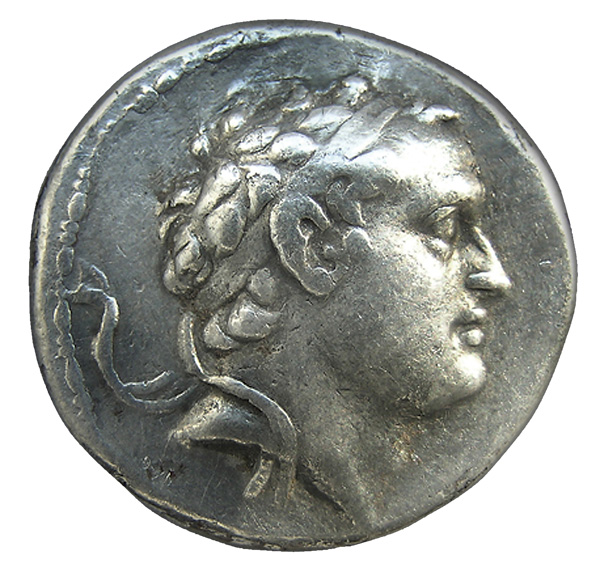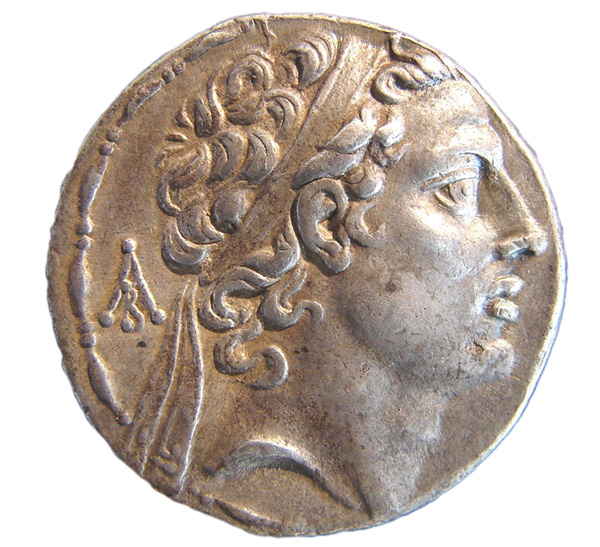
A major new inscription that recently surfaced on the antiquities market and has been acquired by the Israel Museum in Jerusalem sheds dramatic new light on the run-up to the Maccabean revolt in the second century B.C.E.1
Until now, almost everything we know about the Maccabean revolt, which freed the Temple from the desecration of Antiochus IV Epiphanes (the successful campaign to cleanse the Temple is still celebrated by Jews in the festival of Hanukkah), comes from the writings of Josephus and the books of 1 and 2 Maccabees (apocryphal in Protestant and Jewish tradition and deutero-canonical in Roman Catholic tradition). The new inscription, however, provides a more realistic context to some important history of that period.
The stone stela on which the inscription is written is nearly 3 feet high. The top of the stela features a point or gable on each end, with a larger, higher point in the middle. Beneath this central point is an engraved rosette still covered in red paint. The language of the inscription is Greek. Unfortunately, the bottom part of the stela has broken off. But 23 full lines of writing have survived, plus a few more partial lines at the bottom.
The inscription is a so-called dossier: official correspondence intended to be displayed to the public, perhaps in some sanctuary or a forum. This dossier contains three letters: (1) one from King Seleucus IV to his advisor Heliodoros, (2) a letter of transmittal from Heliodoros to Dorymenes (perhaps governor of the satrapy) and (3) a final note from Dorymenes to his subordinate Diaphanes. In effect, the second and third letters (which appear on the stela first) instruct subordinates to fulfill the order of the king. The letters are not so much correspondence as political manifestos; they were written as proclamations to a much wider public beyond the addressees.
Seleucus IV ruled the northern half of the old kingdom of Alexander the Great that fell to the Seleucids after Alexander’s death. Heliodoros, mentioned in 2 Maccabees, was a close advisor to the king. The other two functionaries addressed in the inscription are not clearly identifiable. In the text, Seleucus orders his subordinates to take charge of the sanctuaries in his newly acquired territories of Coele-Syria and Phoenicia, which included Judea.
The dates on the letters inscribed on the stela are quite precise: the summer of 178 B.C.E. Seleucus IV was already ten years into his reign. His predecessor Antiochus III had explicitly recognized Jewish religious autonomy. Now, for whatever reason, Seleucus decided to change that. He appears to have wanted to bring religious observance in his newly acquired territories into congruence with the rest of his empire. He was determined to exercise strict bureaucratic control over the sanctuaries and insure their more efficient fiscal exploitation.
Pursuant to the king’s order at the end of his letter, the dossier on the stela was exhibited in some public place, perhaps a pagan sanctuary near Judea.
The stela may provide background to a famous episode involving a miracle that is recounted in 2 Maccabees 3. In that account, Simon, the administrator of the Temple, quarreled with the high priest. To get even, Simon told an agent of the king about the “untold sums” in the Temple treasury and that “it was possible for them to fall under the control of the king.” King Seleucus chose Heliodoros, who was in charge of his affairs (apparently the same Heliodoros addressed in our stela), “to effect the removal of the reported wealth.” When Heliodoros arrived in Jerusalem, the high priest told him that the money belonged to widows and orphans. “But Heliodoros, because of the orders he had from the king, said that this money must in any case be confiscated.”
When Heliodoros arrived at the Temple to seize the treasury, throngs of Jews were there calling on God’s help. Then Heliodoros and his retinue “were astounded by the power of God, and became faint with terror.” There appeared from heaven “a magnificently caparisoned horse, with a rider of frightening mien” with armor and weapons of gold. The horse proceeded to attack Heliodoros with its front hooves. Two young men, “remarkably strong, gloriously beautiful and splendidly dressed,” stood on either side of the horse and flogged Heliodoros. Men from his retinue put the unconscious and badly wounded Heliodoros on a stretcher and carried him away. Thus was the sovereign power of God recognized.

Heliodoros’s friends then begged the high priest to intervene with the Lord on Heliodoros’s behalf. Because of that, Heliodoros recovered. In gratitude, he offered sacrifices to the Lord and reported all this to the king.
Whatever legendary elements now decorate this story, the new stela suggests that underlying the account in 2 Maccabees is a historical effort by Heliodoros’s monarch Seleucus to obtain access to the Temple treasury and that he was successfully rebuffed—a rebuff that Seleucus would never quietly accept. What immediate steps, if any, toward rebellion the Jews took, we cannot know.

The key passage in Seleucus’s letter to Heliodoros states that “nothing can enjoy its fitting prosperity without the good will of the gods.” Apparently, Seleucus had long assured this prosperity by his involvement in his kingdom’s sanctuaries. But now, with the acquisition of the satrapies of Coele-Syria and Phoenicia, he decided to impose the same policies there:
From the outset we have made it our concern to insure that the sanctuaries founded in other satrapies receive the traditional honors with the care befitting them. But since the affairs in Coele-Syria and Phoenicia stand in need of appointing someone to take care of these [sanctuaries] … Olympiodoros.

With the appointment of Olympiodoros to administer the affairs of the sanctuaries (presumably including the Jewish Temple in Jerusalem), the text of the stela tantalizingly breaks off. As Hannah Cotton and Michael Wörrle state in their scholarly report on the stela, “It is reasonable to assume that Olympiodoros was meant to fulfill in Koile Syria and Phinike [Coele-Syria and Phoenicia] functions similar to those exercised by his predecessors elsewhere in the kingdom. Behind the euphemistic

Seleucus was murdered three years later, in 175 B.C.E., and was succeeded by Antiochus IV Epiphanes, the villain of the Hanukkah story. Less than ten years later (in 169/8 B.C.E.), his forces invaded Jerusalem, massacred its inhabitants and desecrated the Temple. The Maccabean revolt erupted in 165 B.C.E., led by the patriarch Mattathias and his sons, particularly Judah Maccabee (“the Hammer”). The Temple was retaken and the menorah relit. As tradition has it, there was enough oil only for one day, but it lasted for eight days until more oil could be obtained. Hence, Hanukkah is an eight-day festival.
Behind these God-laden events lies human history. There was an Antiochus. There was a desecration of the Temple. There was a Maccabean revolt. And it was driven by the Jews’ determination to exercise their distinctive religion. That Antiochus was motivated by the wealth of the Temple cannot be doubted. The situation described in this inscription reflects one king’s effort to control Jewish religious practice (and the religious treasury). This inscription can be seen as part of the preliminaries that led to the Maccabean revolt.
MLA Citation
Endnotes
1.
The inscription is on permanent loan to the Israel Museum by Michael and Judy Steinhardt, who recently acquired the stela in cooperation with the museum.
2.
Hannah M. Cotton and Michael Wörrle, “Seleukos IV to Heliodoros—A New Dossier of Royal Correspondence from Israel,” Zeitschrift für Philologica und Epigrafia 159 (2007), pp. 191–203. This BAR article is based largely on their scholarly article.

